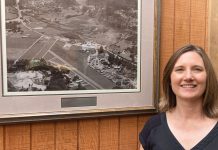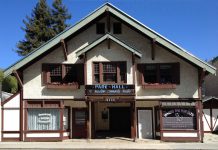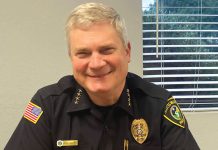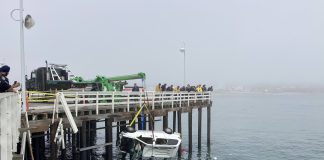
I walked through an Asian-inspired bamboo gate and entered another world: the world of bonsai. Some trees were blooming, others just leafing out, and some had trunks thick and gnarled, as if they’d been alive 200 years — and they had.
At the Boulder Creek garden of the Santa Cruz Bonsai Kai, President Ron Anderson treated me to a tour of 100 specimens in his personal bonsai collection.
The word “bonsai” comes from two Japanese words that provide the most basic definition of this living art form — “bon” is a tray or pot, while “sai” means to plant.
At each turn, I marveled at yet another tree in training. Some were already in classic bonsai pots, while others were still in cut-down nursery pots awaiting their day to be root-pruned and given a shallow tray.
As living things, they are always growing — leaves and stems being pinched, the branches wired into natural-looking shapes, the trunks thickening and sometimes developing nebari, that most sought-after look when the surface roots of the tree are visible above the growing medium.
Anderson told me he had always been interested in Asian and Japanese gardening. It was only five years ago, however, that his father-in-law took him to a bonsai show. He was hooked.
His first bonsai? A boxwood that someone was going to throw out. He gets a lot of his plant material that way. Craigslist has been a great source of old, gnarled plants, he said.
Although many people who are new to the art of bonsai start with a little finished juniper or buy starter plants, collecting wild trees (yamadori) is one of the best ways to acquire new material for bonsai. Anderson found a Sierra juniper in a crevice in the Lake Tahoe area that is probably about 200 years old, from the looks of the trunk. Care was taken to get most of the root system — otherwise, the tree would have been doomed. A tree collected from the wild must be treated to the highest standard of care. But the reward, a unique yamadori bonsai, is a worthwhile prize for spending days, months or years searching for potential material.
Anderson also finds potential bonsai specimens in nurseries, looking mainly for 5-gallon or larger plants with interesting trunks. That way, the tree looks more like one found in nature. The oaks on Highway 152 are good models for bonsai design, he said.
Bonsai enthusiasts strive to evoke the ravages of nature in their trees. Except for young bonsai-in-training, most specimens seem much older than their small size suggests. And they may also appear to be veterans of years of struggle against natural forces. Actual age is of less importance in bonsai than the illusion of age. To that end, Anderson will shave, cut and sometimes burn a trunk or branch to create the look of a lightning strike.
In Anderson’s collection are flowering quince, pear, elm, boxwood, juniper, azalea (it’s picky, he says), cotoneaster, crabapple, olive, persimmon, dawn redwood, coast redwood, strawberry guava, Korean hornbeam, peach and “the Cadillac” of bonsai, the black pine. Anderson has two of those now.
Most bonsai live outdoors, as they do in nature. Very few thrive inside. But for his wife, Anderson is training an olive tree that will eventually live indoors. Starting with a 7-foot tree, it is now 6 inches tall.
What conditions do bonsai like?
Anderson keeps his collection outside year-round. Some are under trees, while others are out in the open, even on frosty nights. During the summer, they get morning sun and afternoon shade. He waters all of them every other day during the growing season, but he cautioned that he knows his plants and their requirements, and others might have to fine-tune their own individual watering schedules.
There is no soil in his planting mix; he prefers a mix of small pumice, red lava and a few other things he’s learned about — though he said he “can’t give his secrets away.” The most important thing is for the mix to have perfect drainage, or the tree roots will rot.
Anderson transplants his deciduous trees every year, because they grow so fast. Evergreen trees are repotted every three years. A root-bound tree, with circling roots in the pot, won’t be healthy enough to grow new root hairs. That will inhibit the growth of the trunk, and it won’t be able to increase in girth.
Deciduous bonsai, Anderson explained, are grown in unglazed trays, usually in soft, dark colors. Colored glazed containers are reserved mainly for shows, although flowering and fruiting plants are sometimes grown in them, too.
The Santa Cruz Bonsai Kai meets at 9 a.m. the third Saturday of each month at Live Oak Grange Hall in Santa Cruz. Workshops are at 7 p.m. the second Wednesday of each month at the Aptos Grange Hall.
Anderson said the club has increased its membership by 30, thanks to its presence on Facebook, which he said is good. Without new members, the knowledge and art couldn’t be passed on.
For information: www.gsbf-bonsai.org/santacruzbonsaikai/.
Jan Nelson, a landscape designer and California certified nursery professional, will answer questions about gardening in the Santa Cruz Mountains. Email her at ja******@*ol.com, or visit www.jannelsonlandscapedesign.com to view past columns and pictures.
At a glance
WHAT: Santa Cruz Bonsai Kai show
When: 10:30 a.m. to 4:30 p.m. Saturday, March 24; repeats March 25
Where: Scotts Valley Community Center, 360 Kings Village Road
Details: Both days will feature a demonstration at 2 p.m. by Katsumi Kinoshita, the famous bonsai sensei. In the demonstration, Kinoshita will show where and how much to trim an ordinary piece of plant material, how to wire the branches to set their growth in the desired shape and how to pot the tiny tree.











